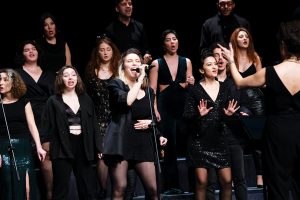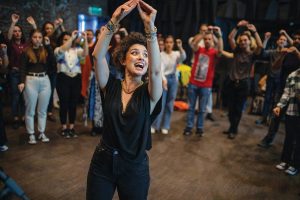Rhythmic Choral Music in Türkiye “5, 6, 7, 8: harmonize”
Başak Doğan, conductor, Türkiye
In this article I will advocate for and explore the need for rhythmic, or jazz/pop, choral music and the urge to create and sing freely as a group. With its unique location bridging East and West, Türkiye has a great musical heritage from a widely diverse cultural background; a thousand layered unique flower, with each layer nourishing the other. However, despite this enormous cultural gift, collective singing is little practiced.
Polyphonic choral singing has been emerging since the Republic was formed (this year marks its hundredth year) and with the remarkable and substantial efforts of musicians and academics it has come a long way, especially in the last 20 years. Having said that, the vast majority of choirs have classical and folk choral music in their repertoire, and while some of those include jazz/pop choral pieces from time to time, there are only a very few jazz/pop choirs that specifically create their selection of repertoire with rhythmic music. When one thinks of choirs here in Türkiye what first comes to mind would be a classical Turkish music choir, where all the singers sing one melodic line together with accompanying traditional instruments. Classical Turkish music is linear, homophonic, microtonal and has an original tonality system called makam. The newer, thriving choral music of the last hundred years is polyphonic and is focused mostly on Western classical and folk music. Since polyphonic choral singing is fairly new to people in Türkiye, especially to non-musical ears, it is really exciting that the upcoming generation of choirs is changing this perception for good.
My own approach to choral singing and my musical universe and understanding completely changed forever after completing my master’s degree in Rhythmic Choir Conducting at the Royal Academy of Music, Denmark, at the one and only RAMA Vocal Center. Through experiencing and being taught rhythm and harmony in a new way using the great improvisational method Vocal Painting (an extensive collection of interactive hand signals, developed by Jim Daus Hjernøe), another level of musical reality opened up for me. Freedom of creativity can go hand in hand with musical precision in a choir, even in an amateur choir, and the results are always amazing – we definitely need more of that here on the Turkish choral scene and, in fact, throughout the world.

The playful nature of jazz/pop and its roots in improvisational creativity mean that it is always a fast and easy way to unlock the potential of choir singers while highlighting the diversity of each individual’s contribution. While singing syncopated and harmonically challenging melodic lines together as a group, singers will develop a more profound understanding of time and tonality in music. The importance of being exactly together in rhythm, having the same tone color in order to maintain a balanced blend and good intonation, and starting and ending every note together are the core components of making brilliant and groovy music in a jazz/pop choir. The practice of these main features of rhythmic music is certainly very beneficial for any type of musical genre. For instance, when I work with my choir Chromas on different tone colors in a pop piece like You’re All I Need To Get By (The Swingles), the tonal quality of a completely different genre piece like Cloudburst by Whitacre also improves. In my opinion, what makes the rhythmic choral repertoire better also directly makes collective singing better as a whole – whether it is contemporary, classical or folk.
Furthermore, with the help of Vocal Painting in a choral setting you can always push the boundaries of singing and self-expression, which always leads to musical excellence. I strongly believe that building an inviting open space for every individual to express their authentic truth is fundamental to making good music. With the pedagogical approach of Vocal Painting, time flies by while singing improvisational compositions of the moment and both the individual singers and the choir further their musicianship. It is easier to work on a musical piece when there is flow, when one is in the moment and is mindful to one’s musical perception. By creating an open and playful environment every singer experiences the process of making music in as true and real a way as possible.

As much as I am genuinely glad that there is an ever-increasing number of jazz choirs and vocal ensembles in Türkiye, the urge and great need to have more choirs within these new genres is quite apparent. In Türkiye, vocal pop music has been prominent for decades and there are key figures that sing in harmony and in groove, so why not incorporate this music into choirs and make it challenging and innovative for young singers? I imagine more and more choirs founded every day, in every city; more people singing jazz/pop a capella and creating freely as a singing community. Young people’s musical interest is largely r&b, soul, rock and pop vocal music – having a choir that focuses on that music would attract them and give them a choral space where they feel they belong. Starting jazz/pop choirs especially for young people would have an amazing impact on the future growth of the choral scene.
 Başak Doğan is an innovative conductor whose unique style has been turning heads around the world. After finishing her Master’s in Philosophy of Music at Boğaziçi University in Istanbul, she got her second master’s degree in Rhythmic Choral Conducting at the Royal Academy of Music, Denmark, with the thesis ‘Intuitive Conducting’. As a versatile conductor she appears at numerous choral events, leading singers from all age groups and has gained international recognition with her choir Chromas. Best known for blending different styles, Başak has developed a distinctive conducting method. Her enthusiasm for bringing her own cultural background into the choral world has had an impact on rhythmic choral music. Central to her style is “Vocal Painting”: allowing the choir to create “music of the moment”. Her new initiative “Vokal Akademi” has become the center for all the singers who want to take their singing to a new level and further their music career.
Başak Doğan is an innovative conductor whose unique style has been turning heads around the world. After finishing her Master’s in Philosophy of Music at Boğaziçi University in Istanbul, she got her second master’s degree in Rhythmic Choral Conducting at the Royal Academy of Music, Denmark, with the thesis ‘Intuitive Conducting’. As a versatile conductor she appears at numerous choral events, leading singers from all age groups and has gained international recognition with her choir Chromas. Best known for blending different styles, Başak has developed a distinctive conducting method. Her enthusiasm for bringing her own cultural background into the choral world has had an impact on rhythmic choral music. Central to her style is “Vocal Painting”: allowing the choir to create “music of the moment”. Her new initiative “Vokal Akademi” has become the center for all the singers who want to take their singing to a new level and further their music career.
Edited by Laura Massey, UK